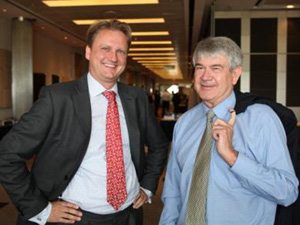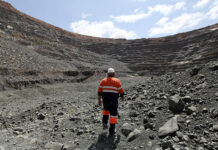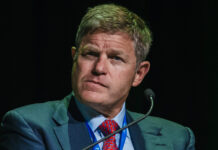
WHEN Pallinghurst Resources CEO, Arne Frandsen, announced to the market in May that the equity group was moving to buy out its 75%-owned coloured gemstone miner Gemfields, it was unlikely that the former banker envisaged the extent of opposition to its takeover offer.
In the two months since tabling the offer and outlining plans to transform from a pure equity structure to an operating company, the JSE-listed group has been forced to defend itself against enthusiastic disapproval of the deal, narrowly avoided a bidding war, but then shedding two long-standing non-executive directors.
“What do you do if you own 75% in a company whose share price has halved, which is taking on debt and is not making money?” Frandsen says in defence of the Gemfields bid: “I think it is a legitimate concern.”
Ninety-six percent of Pallinghurst shareholders in May approved a deal that would see it buy the issued share capital of Gemfields that it did not already own for 1.91 new Pallinghurst shares per Gemfields share. Shortly thereafter, some 75.3% of Gemfields shareholders bought into the offer, exceeding the 75% majority required to delist Gemfields.
Pallinghurst’s offer followed indications by the equity group that it was concerned about an apparently stalled Gemfields share price that had not seen significant upside since the purchase of the Kagem emerald mine, in Zambia, eight years ago. “What we were trying to do is say, listen. We were concerned and something had to be done,” he said.
But despite majority approval from shareholders on both sides of the transaction, vigorous opposition to the takeover emerged in both the press and from within the gemstone miner itself – much to Frandsen’s apparent bemusement.
I don’t buy the concept that the majority of the shareholders are grumpy – Arne Frandsen
An independent committee established by Gemfields to assess Pallinghurst’s takeover proposal, which included its CEO Ian Harebottle, said at the time that the “unsolicited” offer appeared to have been driven by Pallinghurst’s proposed restructuring to an operating company, which sought to “… preserve the Pallinghurst investment managers’ own self-interests at the expensive of the independent shareholders of Gemfields”.
It added that Pallinghurst was illiquid and exposed minority shareholders in Gemfields to more volatile commodities, such as iron ore, in which Pallinghurst is invested.
Several analysts have also expressed opposition to a deal they said would devalue Gemfields’ stock. One London-based analyst declined to comment for this article “… because I have nothing nice to say about Pallinghurst”. Harebottle also declined a request for comment.
Frandsen’s position, meanwhile, remains one of incredulity at the vehement hostility towards to deal. “It’s typically ‘an anonymous source’ complaining about the deal. We now have 96% of the Pallinghurst shareholders and almost 90% of the Gemfields shareholders in favour, so maybe we are actually doing what the shareholders want us to do. I don’t buy the concept that the majority of the shareholders are grumpy. We are not offering money, we are offering a restructuring,” he said.
The Pallinghurst takeover was not intended to be interpreted as an overhaul of the gemstone miner, but rather an effort to pool Pallinghurst and Gemfields’ management, shares, efforts and structure to regain market share and lift share value. “I don’t agree that the takeover should leave a bad taste in some people’s mouths, because [Gemfields’ current structure] isn’t working. The Kagem mine, for example, has produced $55m less revenue this year. It’s loss-making right now.
“There was a lot of hype in the press and a lot of prices and jewellery and fancy things, but fundamentally, [Gemfields] was not making money. We own 75% of this business, so it is our business. It’s a little like saying that Anglo American doesn’t own Anglo Platinum,” he said.
In a last-ditch attempt to extract a better offer, or pressure Pallinghurst into lifting its bid, a Gemfields committee enlisted another offer for the company, a rival $311m all-cash proposal from Hong Kong-based Fosun Gold. It valued Gemfields shares at 45p apiece. This despite the majority of Gemfields’ shareholders having already approved Pallinghurst’s offer. Frandsen said he only discovered the existence of an opposing offer in the press.
“In my mind, that was an opportunistic bid. We were offering paper. So we were saying to people – don’t cash out now, we need to get the structure right and then you will participate in the upside. I’m disappointed that the technical committee recommended a cash offer with a value-to-company only marginally higher over our deal for paper, which was done the right way and was bulletproof – if there is such a word,” he said.
EARLY casualties of the Gemfields deal and restructuring plan came in the form of Pallinghurst non-executive directors, Clive Harris and Stuart Platt-Ransom, who resigned ahead of the annual general meeting (AGM) in early July following opposition to their re-election.
Shareholders subsequently approved a new remuneration policy for management of the new operating company, which will see principal managers – including Pallinghurst chairperson Brian Gilbertson, Frandsen, and CFO Andrew Willis – kept on as salaried employees for at least the next five years.
Frandsen’s attention will now turn to transforming Pallinghurst into the operating company envisaged, which will involve the delisting of Gemfields from the Aim by the end of July and its incorporation into the larger group.
“Our focus is on getting back to basics and getting the fundamentals right,” Frandsen said of his plans for the new group. “We’re going to focus on getting the ‘pistons’ of the Kagem mine and Montepuez ruby mine in Mozambique to really fire at full speed. It’s not like we are buying a company in Uzbekistan that we have never seen. We created these companies, now we’re just taking them in-house to ensure direct accountability.”
With Pallinghurst reluctant to leverage debt, the group is likely to only start paying dividends once the existing Gemfields debt is worked out of the system. “But, fundamentally, we want equity exposure and equity returns and part of equity returns is a good, healthy dividend. I personally believe that when you generate a cash flow, you should share it with the shareholders,” said Frandsen.
We created these companies, now we’re just taking them in-house to ensure direct accountability – Arne Frandsen
“We obviously need to get our feet under the table first and integrate the business. Give us a few months to do that and then hopefully the increased market value will follow.”
According to Frandsen, the group is unlikely to further consolidate its other major assets, namely its stake in South African-based manganese mine Tshipi and its open-cast platinum group metals (PGM) operation Sedibelo, in the North West province, in the same way as has been done with Gemfields.
“I think it is slightly different because Gemfields’ assets are outside of South Africa, where there is no Mining Charter, black economic-empowerment requirements, et cetera. That being the case, we can’t really fully hold these assets,” said Frandsen.
Frandsen has not, however, ruled out a possible listing of Sedibelo on the Johannesburg bourse, but added that the absence of debt in the company removes the immediate need to access to capital markets.
“Sedibelo is really tightly held between us, the Industrial Development Corporation (IDC) and the community, and none of us are sellers. We don’t need to raise capital, and it’s not a great public market on the JSE for platinum stock. To blow against the hurricane right now is perhaps not the right time,” he said.
Pallinghurst’s reluctance to interfere with the operational status quo at Sedibelo may also be explained by the recent successful testing of new platinum refining technology developed by Sedibelo Platinum Mine director, Keith Liddell.
Recently unveiled to the market after almost five years under wraps, the Kell beneficiation technology comprises a chemically-based leach process that consumes less than a fifth of electricity required to operate standard platinum smelters and refineries that burn the impurities from platinum concentrate. The technology also allows for the extraction of cobalt from the concentrate, unlike conventional smelting techniques.
Project partners Lifezone and the IDC will assist Pallinghurst with the commercial development of the technology, which is tipped to transform platinum beneficiation in Southern Africa and dramatically cut processing costs by as much as 80%.
Critically, in May Pallinghurst struck a deal with the government of Zimbabwe that will see up to five Kell plants built in the country, with Zimbabwe obliged to provide adequate concentrate feedstock to ensure full capacity utilisation of the refineries. The Memorandum of Understanding will ultimately result in all PGM production in the country being processed through Kell plants within five years.
Having completed a bankable feasibility study on the roll-out of the technology, Frandsen said that a modular Kell plant will cost about $100m and can be constructed in about 18 months. Sedibelo will operate Kell on a toll basis, although potential third-party customers would also be able to make equity investments in the construction of modules.
Currently in discussions with several junior and new entrant mining companies in South Africa and Zimbabwe regarding the introduction of the technology, Frandsen believes the smelters offer a solution the beneficiation and indigenisation requirements of mines in the region.
“In terms of [Zimbabwe 51%] indigenisation requirements, [Kell allows miners to] indigenise at the level of beneficiation and not at the level of the mine, and I think that the mining companies will love that.
“The fact that it uses 80% less electricity than normal smelters is also great for a country like South Africa, where electricity supply is notoriously unstable,” he said.










